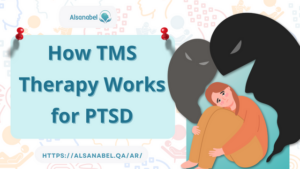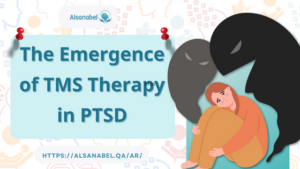TMS Therapy Offers a Lifeline for PTSD Patients 2024
- Category TMS benefits
Navigating the stormy seas of the mind can often leave individuals with post-traumatic stress disorder (PTSD) feeling adrift in a vast ocean of past memories and persistent distress. However, the quest for respite has been imbued with renewed hope, thanks to the groundbreaking advancements in medical science. Transcranial Magnetic Stimulation (TMS) therapy has emerged as a beacon of relief for those contending with the invisible wounds of PTSD. Endorsed by the body of research including a pivotal study in the American Journal of Psychiatry, TMS therapy is an FDA-approved, non-invasive treatment that is lighting the way towards recovery. Targeting the dorsolateral prefrontal cortex (DLPFC) through focused magnetic impulses, TMS has demonstrated efficacy in providing substantial relief for PTSD sufferers—without the reliance on medication, sedation, or anesthesia.
Table of Contents
ToggleHow TMS Therapy Works for PTSD
TMS therapy is a non-invasive treatment using magnetic fields to stimulate brain nerve cells, known for depression but also promising for PTSD. Here’s how it works:

- Targeted Brain Stimulation: An electromagnetic coil placed on the scalp generates magnetic pulses, stimulating mood-regulating brain regions like the prefrontal cortex.
- Neuroplasticity: TMS induces changes in neural activity, potentially regulating abnormal circuits linked to PTSD symptoms.
- Normalization of Brain Activity: Altered brain activity in PTSD patients, like hyperactivity in the fear-regulating amygdala and reduced activity in emotion-regulating regions, may be normalized with TMS.
- Modulation of Neurotransmitters: TMS may affect neurotransmitter levels such as serotonin and dopamine, crucial for mood and stress response, potentially alleviating PTSD symptoms.
- Clinical Evidence: While research is ongoing, studies suggest TMS can reduce PTSD symptoms like intrusive thoughts and hyperarousal, with some patients showing significant improvement.
- Treatment Protocol: Multiple sessions over weeks, tailored to individual needs, with daily sessions of repetitive TMS or intermittent theta burst stimulation targeting specific brain areas.
- Adjunctive Therapy: TMS is often used alongside therapies like CBT or exposure therapy for better outcomes and long-term recovery.
While promising, more research is needed to understand TMS’s effectiveness, optimal parameters, and long-term benefits. Consultation with a healthcare provider is crucial for those considering TMS for PTSD.
Efficacy of TMS Therapy in PTSD
TMS sessions shows promise in treating PTSD, though research is limited. Existing studies suggest:
- Symptom Reduction: TMS targets brain areas linked to PTSD symptoms, like the prefrontal cortex, potentially easing intrusive memories, hypervigilance, and avoidance.
- Mood and Anxiety Improvement: TMS may alleviate depressive and anxiety symptoms common in PTSD by regulating mood-related neural circuits.
- Cognitive Enhancement: TMS might enhance cognitive functions such as attention and decision-making, addressing deficits often seen in PTSD patients.
- Adjunctive Therapy: TMS could complement existing PTSD treatments like therapy and medication, potentially improving overall outcomes.
- Safety and Tolerability: TMS is generally safe and well-tolerated, with minimal side effects compared to medications, making it appealing for those intolerant to drugs.
However, more robust research, including large-scale trials and long-term studies, is needed to confirm efficacy and optimal usage. Tailored treatment plans are essential for maximizing TMS benefits in PTSD management.
TMS Therapy Process for PTSD
The process of TMS sessions for PTSD treatment involves several key steps:
- Initial Assessment: A thorough evaluation by a healthcare provider determines if TMS is suitable based on medical history and symptoms.
- Treatment Planning: A personalized plan is crafted, specifying stimulation parameters based on individual needs.
- Educational Session: The individual learns about TMS, its benefits, and potential side effects to address any concerns.
- Pre-Treatment Preparation: Prior to sessions, avoiding substances affecting brain response may be advised, alongside baseline assessments.
- TMS Session Protocol: The individual sits comfortably as the TMS coil stimulates the targeted brain region with magnetic pulses.
- Session Frequency and Duration: Daily sessions over weeks last 20-30 minutes, with the duration and frequency varying.
- Monitoring and Adjustment: Healthcare providers closely track progress, adjusting parameters as needed.
- Assessment of Treatment Outcomes: Periodic assessments track symptom improvement and guide ongoing treatment.
- Maintenance and Follow-Up: Maintenance sessions sustain gains, with regular follow-ups for monitoring and adjustments.
Overall, TMS therapy prioritizes individualized care, close monitoring, and ongoing evaluation to optimize therapeutic benefits, requiring collaboration between the individual and their healthcare provider.
The Emergence of TMS Therapy in PTSD
The integration of Transcranial Magnetic Stimulation (TMS) therapy into Post-Traumatic Stress Disorder (PTSD) treatment marks a significant advancement in mental health care. Here’s how TMS therapy has emerged as a potential option for PTSD:

- Research Findings: Studies have demonstrated TMS’s safety and effectiveness in reducing PTSD symptoms, sparking interest in its therapeutic potential beyond depression.
- FDA Approval: While TMS is FDA-approved for depression, ongoing research and trials are evaluating its efficacy for PTSD, indicating potential future approval.
- Mechanism of Action: TMS delivers magnetic pulses to brain regions linked to mood regulation and emotional processing, aiming to normalize abnormal activity patterns seen in PTSD.
- Non-Invasive Nature: TMS is non-invasive, contrasting with treatments like ECT or DBS, making it safer and more tolerable for PTSD patients.
- Customized Treatment Protocols: TMS can be tailored to individual needs, allowing clinicians to adjust stimulation parameters for optimal outcomes.
- Potential for Personalized Medicine: Advances in neuroimaging and biomarker research may lead to personalized TMS protocols based on brain activity and genetic markers, enhancing treatment response.
- Integration with Psychotherapy: TMS is often combined with psychotherapy and medication management, enhancing symptom relief and long-term recovery.
Overall, the emergence of TMS therapy in PTSD treatment offers promise in addressing the disorder’s complex neurobiological mechanisms. Further research is needed to clarify its role and expand access to this innovative treatment for those in need.
And there we have it—a journey through the hope that TMS therapy offers to those grappling with PTSD. It’s our mission to shed light on the therapies that could change lives, and TMS therapy is shining bright with potential. We sincerely thank you for taking the time to delve into this topic with us. Your thoughts and experiences are invaluable, so please share them. Do you or someone you know have any experiences with TMS therapy? What advancements in PTSD treatment are you hoping to see in the future? We’re listening, and your input could be the beacon that guides someone to their lifeline.









